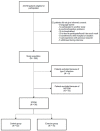Association between engagement in exercise training and peak cardiac biomarker concentrations following ST-elevation myocardial infarction
- PMID: 37073175
- PMCID: PMC10106052
- DOI: 10.1136/bmjsem-2022-001488
Association between engagement in exercise training and peak cardiac biomarker concentrations following ST-elevation myocardial infarction
Abstract
Background: Regular exercise training is an important factor in prevention of myocardial infarction (MI). However, little is known whether exercise engagement prior to MI is related to the magnitude of post-MI cardiac biomarker concentrations and clinical outcomes.
Objectives: We tested the hypothesis that exercise engagement in the week prior MI is related to lower cardiac biomarker concentrations following ST-elevated MI (STEMI).
Methods: We recruited hospitalised STEMI patients and assessed the amount of exercise engagement in the 7 days preceding MI onset using a validated questionnaire. Patients were classified as 'exercise' if they performed any vigorous exercise in the week prior MI, or as 'control' if they did not. Post-MI peak concentrations of high-sensitive cardiac troponin T (peak-hs-cTnT) and creatine kinase (peak-CK) were examined. We also explored whether exercise engagement prior MI is related to the clinical course (duration of hospitalisation and incidence of in-hospital, 30-day and 6-month major adverse cardiac events (reinfarction, target vessel revascularisation, cardiogenic shock or death)).
Results: In total, 98 STEMI patients were included, of which 16% (n=16) was classified as 'exercise', and 84% (n=82) as 'control'. Post-MI peak-hs-cTnT and peak-CK concentrations were lower in the exercise group (941 (645-2925) ng/mL; 477 (346-1402) U/L, respectively) compared with controls (3136 (1553-4969) ng/mL, p=0.010; 1055 (596-2019) U/L, p=0.016, respectively). During follow-up, no significant differences were found between both groups.
Conclusion: Engagement in exercise is associated with lower cardiac biomarker peak concentrations following STEMI. These data could provide further support for the cardiovascular health benefits of exercise training.
Keywords: Cardiology physiology; Exercise; Physical activity.
© Author(s) (or their employer(s)) 2023. Re-use permitted under CC BY-NC. No commercial re-use. See rights and permissions. Published by BMJ.
Conflict of interest statement
Competing interests: None declared.
Figures


References
LinkOut - more resources
Full Text Sources
Research Materials
